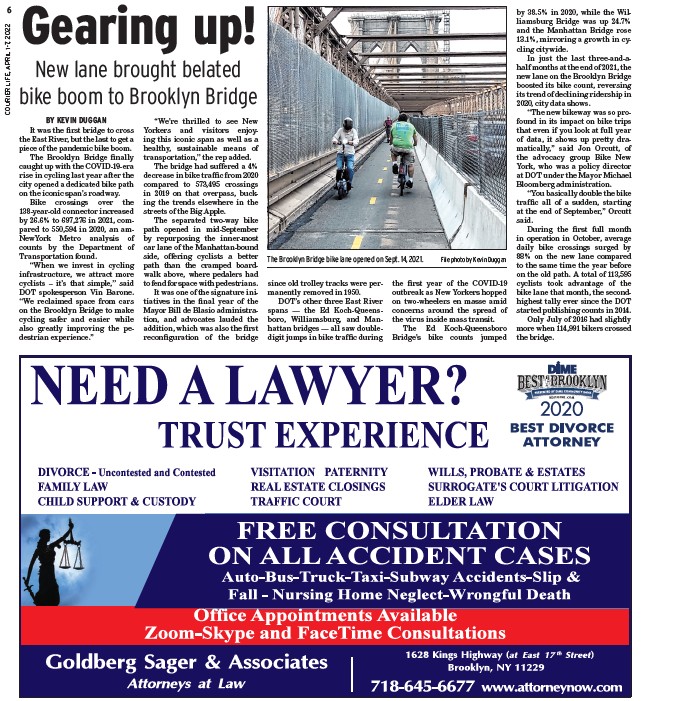
6
COURIER LIFE, APRIL 1-7, 2022
BY KEVIN DUGGAN
It was the first bridge to cross
the East River, but the last to get a
piece of the pandemic bike boom.
The Brooklyn Bridge finally
caught up with the COVID-19-era
rise in cycling last year after the
city opened a dedicated bike path
on the iconic span’s roadway.
Bike crossings over the
138-year-old connector increased
by 26.6% to 697,276 in 2021, compared
to 550,594 in 2020, an am-
NewYork Metro analysis of
counts by the Department of
Transportation found.
“When we invest in cycling
infrastructure, we attract more
cyclists – it’s that simple,” said
DOT spokesperson Vin Barone.
“We reclaimed space from cars
on the Brooklyn Bridge to make
cycling safer and easier while
also greatly improving the pedestrian
experience.”
“We’re thrilled to see New
Yorkers and visitors enjoying
this iconic span as well as a
healthy, sustainable means of
transportation,” the rep added.
The bridge had suffered a 4%
decrease in bike traffic from 2020
compared to 573,495 crossings
in 2019 on that overpass, bucking
the trends elsewhere in the
streets of the Big Apple.
The separated two-way bike
path opened in mid-September
by repurposing the inner-most
car lane of the Manhattan-bound
side, offering cyclists a better
path than the cramped boardwalk
above, where pedalers had
to fend for space with pedestrians.
It was one of the signature initiatives
in the final year of the
Mayor Bill de Blasio administration,
and advocates lauded the
addition, which was also the first
reconfiguration of the bridge
since old trolley tracks were permanently
removed in 1950.
DOT’s other three East River
spans — the Ed Koch-Queensboro,
Williamsburg, and Manhattan
bridges — all saw doubledigit
jumps in bike traffic during
the first year of the COVID-19
outbreak as New Yorkers hopped
on two-wheelers en masse amid
concerns around the spread of
the virus inside mass transit.
The Ed Koch-Queensboro
Bridge’s bike counts jumped
by 38.5% in 2020, while the Williamsburg
Bridge was up 24.7%
and the Manhattan Bridge rose
13.1%, mirroring a growth in cycling
citywide.
In just the last three-and-ahalf
months at the end of 2021, the
new lane on the Brooklyn Bridge
boosted its bike count, reversing
its trend of declining ridership in
2020, city data shows.
“The new bikeway was so profound
in its impact on bike trips
that even if you look at full year
of data, it shows up pretty dramatically,”
said Jon Orcutt, of
the advocacy group Bike New
York, who was a policy director
at DOT under the Mayor Michael
Bloomberg administration.
“You basically double the bike
traffic all of a sudden, starting
at the end of September,” Orcutt
said.
During the first full month
in operation in October, average
daily bike crossings surged by
88% on the new lane compared
to the same time the year before
on the old path. A total of 113,595
cyclists took advantage of the
bike lane that month, the secondhighest
tally ever since the DOT
started publishing counts in 2014.
Only July of 2016 had slightly
more when 114,991 bikers crossed
the bridge.
The Brooklyn Bridge bike lane opened on Sept. 14, 2021. File photo by Kevin Duggan
Gearing up!
New lane brought belated
bike boom to Brooklyn Bridge